Research. Upgrades. The topic is something I’ve been thinking about quite a bit lately. I think some of the interest comes from my renewed attention to Warcraft 3 thanks to Reforged (I haven’t refunded it and keep coming back to the game in spite of the flaws). But, most strategy games include an upgrade system of some sort. Regarding WarCraft 3: I personally find the upgrade systems in Blizzard’s games (specifically, the WarCraft and StarCraft franchises) a bit lacking and have been trying to articulate precisely why. But… more on that later. We’ll work our way back around to talking about that.
Gating mechanisms are pretty integral to RTS design: population cap curbs army growth, resources force the player to make tough choices about how they are going to define their core strategy at any given point in the game. And for many games, a big part of this, too, are research or upgrade systems.
While resources serve to force the player to make economical decisions to pursue a strategy (and prevent them from pursuing too many paths towards victory at once), and population cap gates how fast a player is able to expand their total military might, research serves as a kind of ‘god of the gaps’ – it’s often used to gate access to game-changing abilities and to handle how early-game units scale into the end game.
At its best, research and upgrade allow the player to adapt to the battlefield and increase replayability of a game by presenting different choices and interaction. The permanence of research is something else of interest to me: often, upgrades in strategy games are elements that cannot be removed once gained. You can’t lose that +1 armor for your infantry, though its impact is variable because, of course, you can lose your infantry.
At its worst, research and upgrades can provide the player with rote-memory tasks and punish them with invisible numerical disadvantages for forgetting to click the right buttons at the right time.
Let’s dig in.
Definitions – What are we working with?
I always like to start by defining my terms. Making sure that everyone involved in discussing a particular topic is on the same page regarding what, specifically, is being discussed is a big priority of mine. So, apologies if this feels a bit reductive or an unnecessary explanation. I just put a lot of stock in being clear.
‘Research’ and ‘upgrades’ encompass a wide variety of possible systems in strategy games.
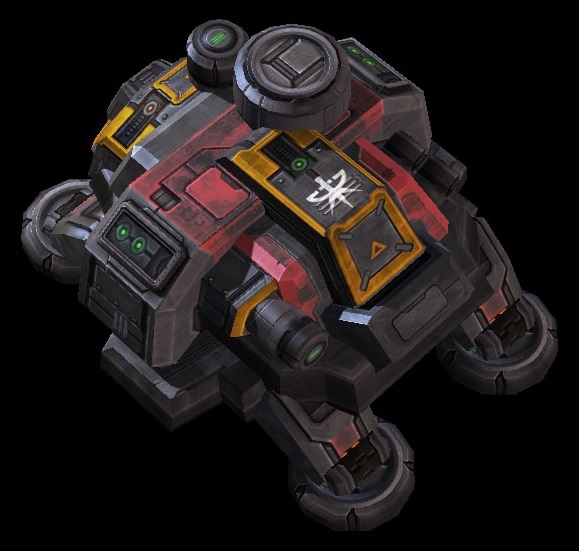
In StarCraft and WarCraft games, ‘Research’ entails functions contained withing some structures which permanently modify one or more types of unit from the point at which the function concludes. This could unlock new abilities, or modify attributes such as attack damage. This has become one of the standard models for upgrades in RTS.
In Command and Conquer games, there’s no ‘research’ as such – simply placing a new building expands the player’s tech tree. Kane’s Wrath is one major exception here, where some buildings do contain unit upgrades. It is interesting to me that Red Alert 3 stepped back from this.
Another type of research we see in strategy games is what I’ll call a ‘meta-tree’. It exists as a separate menu within the game’s UI that contains one or more branching paths enabling access to new units, structures, and unit abilities, and enhancements. Sometimes, the nodes on these menus are activated by unlocking a previous node; sometimes, they’re activated based on game performance (killing enemy units) or by building certain structures that enable them.
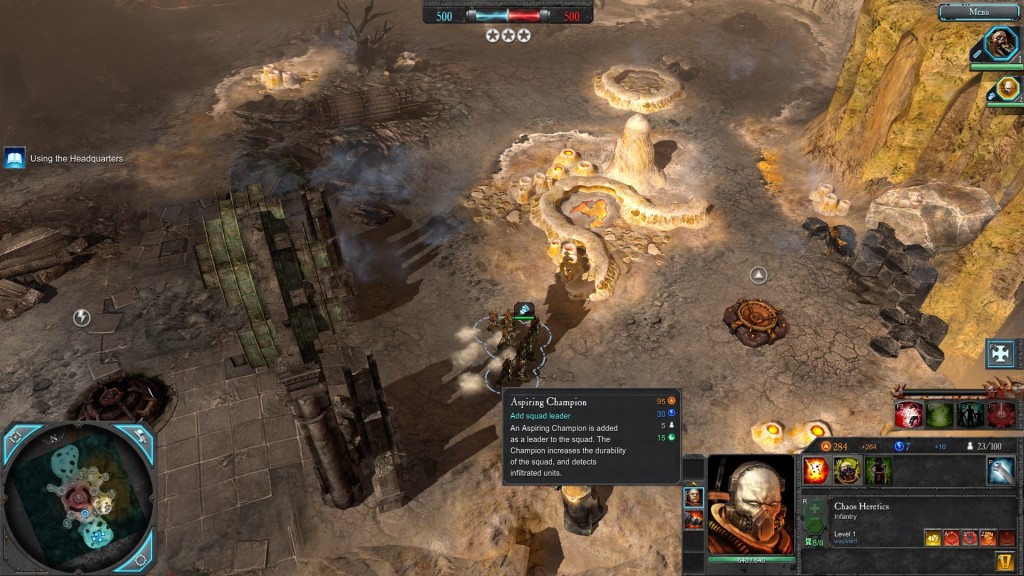
There’s another type of ‘research’ or upgrade that we see: Relic’s Dawn of War Company of Heroes games are a good example of this 3rd main category. These are upgrades that are applied to individual units: modifications or abilities granted after a unit interacts with a specific game object. BAR rifles on US forces, for instance.
Whether they exist on their own menu or ‘contained’ within structures, the effects they have are largely consistent. So this brings, us, finally, to a definition:
Upgrades are permanent or persistent modifiers to game pieces (that is, units or structures) that alter how these game pieces interact with other game pieces in positive ways. Furthermore, upgrades require player interaction, planning, and resources to acquire.
The process of acquiring upgrades, which takes time, is called ‘Research’. Below, I want to address both the method of acquiring upgrade modifiers, and to discuss their functions. So, we’ll look at how you get upgrades, and what they do.
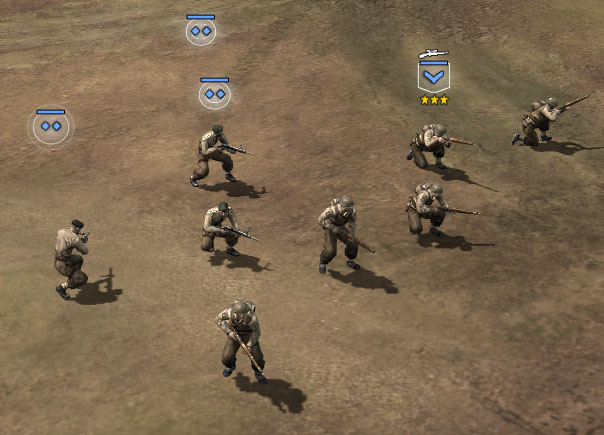
Originally, I had written a couple of paragraphs here about how veteran status bonuses from games like Company of Heroes, and hero level stat increases and ability gain are not, technically, upgrades for the purposes of this article. In the (too) many weeks I’ve been tinkering with this piece, I’ve come to change my view on that and so I’ve removed the section.
Going forward, I am going to include any statistic-based bonus to units that is derived by player action and some sort of limiting factor an upgrade. Hero upgrades and unit veterancy might not, strictly speaking, cost resources in the same way that buying a new unit costs resources, but right now I see that as a distinction without a difference. Player action and the limited resource of the player’s time and attention and ability to keep the unit alive are important considerations. These upgrades aren’t acquired through research, but to me they’re still “upgrades” of a sort, though I think I want to address XP and veterancy in its own article.
Upgrade and Research Design – What is the goal?

We’re going to start by talking about how you get upgrades onto your units. For the purposes of categorization, I’m labeling all of the various methods of making your army better under the heading of ‘research’ though as we’ve already addressed, many of the methods of improvement fall into their own unique buckets. A Warcraft hero or Company of Heroes Rifleman Squad leveling up/gaining veteran status isn’t really a ‘research’ action in the same way as clicking on a +1 damage upgrade in a Blacksmith or Armory, but it does involve an expenditure of time, attention, and oftentimes resources in order to keep these units alive and improve them individually.
RTS, as with many genres of game, is defined in part by a constant struggle to include enough depth and breadth to make gameplay consistently replayable and interesting across the longest possible time, contrasted against the need to the game understandable and straightforward enough to not drive players away or annoy them with pointless busywork or poorly implemented systems that they have to fight against in order to succeed.
At their worst, upgrade systems add complexity without doing much about depth. They add busywork button-clicks whose main point of interest is the cost and timing that are associated with them. At their best, upgrade systems add interesting choices to a game, allowing players to specialize and forcing presenting the player with non-trivial options.
All of this, however, begs the question of what the purpose of upgrade systems is in the first place. What’s the goal?

I see a couple of objectives for research. First, they’re put in place as another focusing and gating mechanism. The player has a lot of options in a strategy game, and must select among them using the limited resources of their income/economy as well as their their time to define how they’re going to approach the game. This is especially true in the early minutes of an RTS match, but often remains broadly true regardless of match stage.
A player trying to build everything is never going to be effective: players in RTS typically strive to find the most time- and resource-efficient way to field a winning army composition. How few resources can I use to get to a point where I overpower the enemy?
This is where upgrades can come in. Typically, in the early stages of a competitive match, choosing to research an upgrade can cost as much as a production structure or a handful of units. Take one at the wrong time, and your army will be too small to handle what your opponent will throw at you. But, take an upgrade too late and your army won’t have the firepower it needs. As with so much of RTS gameplay, knowing when to click that button (in games where this is the model for applying upgrades to units) is a matter of some finesse and precision.
Buildings provide a spatial and temporal decision tree: when to build, where to build (do I want to hide this structure? Is it vulnerable? Can i protect something by blocking that thing off with my structure? The implications of having whatever is building the structure not doing something else).
Training and positioning of an army are another unique decision tree: where will this unit be most effective? When do I be aggressive? When do I defend? et cetera.
Research is unique in that it often cannot be lost and acts as mostly a force multiplier to something else in the game: this unit type performs better: it harvests more Lumber, or deals more damage, or has a new ability that it didn’t have before. The money spent on research makes the other money you spent on units or buildings to be worth more.
Personally, I take what might be an kind of unscientific approach to design in strategy games. I find excitement in having a wide variety of avenues of approach to the game. In fact, my whole definition of game balance in general boils down to: how many viable responses or avenues of approach does a player have at any given time?
If a player has only one real meaningful choice that they can make to improve their position and attempt to win, the game is not balanced, no matter how powerful that 1 approach might be.
I also try to measure the difficulty of performing a particular action versus the difficulty of stopping it, bearing in mind the weight of how game-changing the action would be if successful. Basically: how many choices does the player have, how risky are they, and what is the impact if they pull it off, and how many viable choices does the opponent have in turn?
Basically, I feel like the player’s paths to choose how to approach a situation in a strategy game are what drives the interest in a strategy game. And so, that’s how I judge the effectiveness of upgrades in strategy games. What options do they open up for the player? What interesting choices do they present?
Strategy-Based Upgrade Design
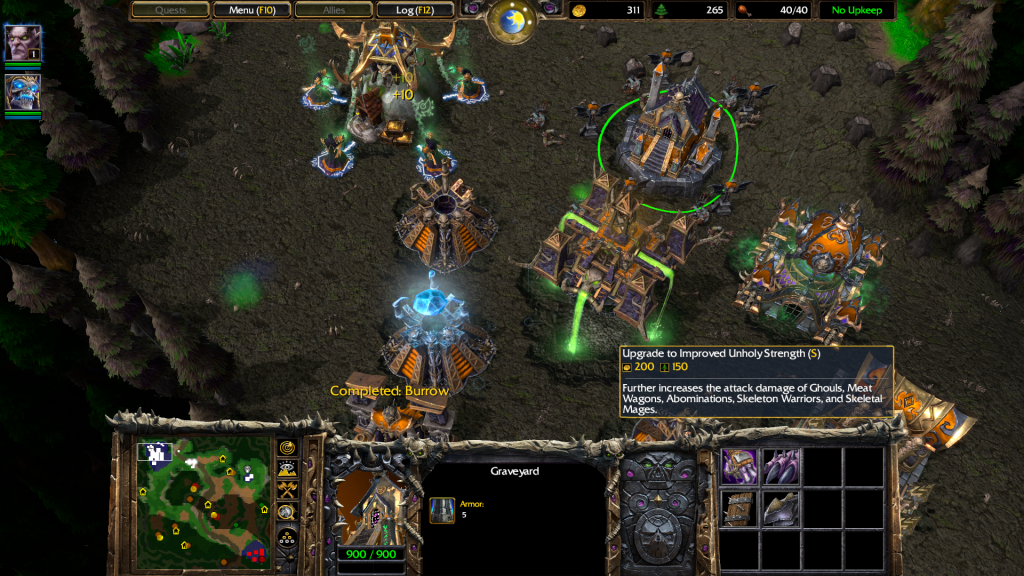
In my mind, the weapon and armor upgrades often seen in Blizzard RTS design are ‘bottom of the barrel’ in terms of how research can shape a game.
Now look. It’s not that these systems are bad per se, just that to me they form a less than ideal scenario. Blizzard know what they’re doing, of course. They’re a celebrated game studio with probably tens or hundreds of millions of players of their games, and I’m just one fat guy behind a computer.
There’s a delicate balance to the system they implemented. Their designers craft precise interactions that are modified by these upgrades. One excellent example is how zealots and zerglings interact based on their damage and armor upgrades: a zergling with +1 armor over the Zealots attack upgrades will survive an extra hit from the Zealot. This has a lot of implications on how Zerg can stand up to Protosss in StarCraft 2.
Compare this to an example in Grey Goo. Normally, the Human faction’s Lancer unit deals Void Ray like damage to enemies: it deals increasing damage over time to a single target. There’s an upgrade in the game called ‘Railgun Systems’ that swaps out the Lancer’s attack: instead of single target anti-armor, the Lancer’s attack does damage in a line against swarms of light units.
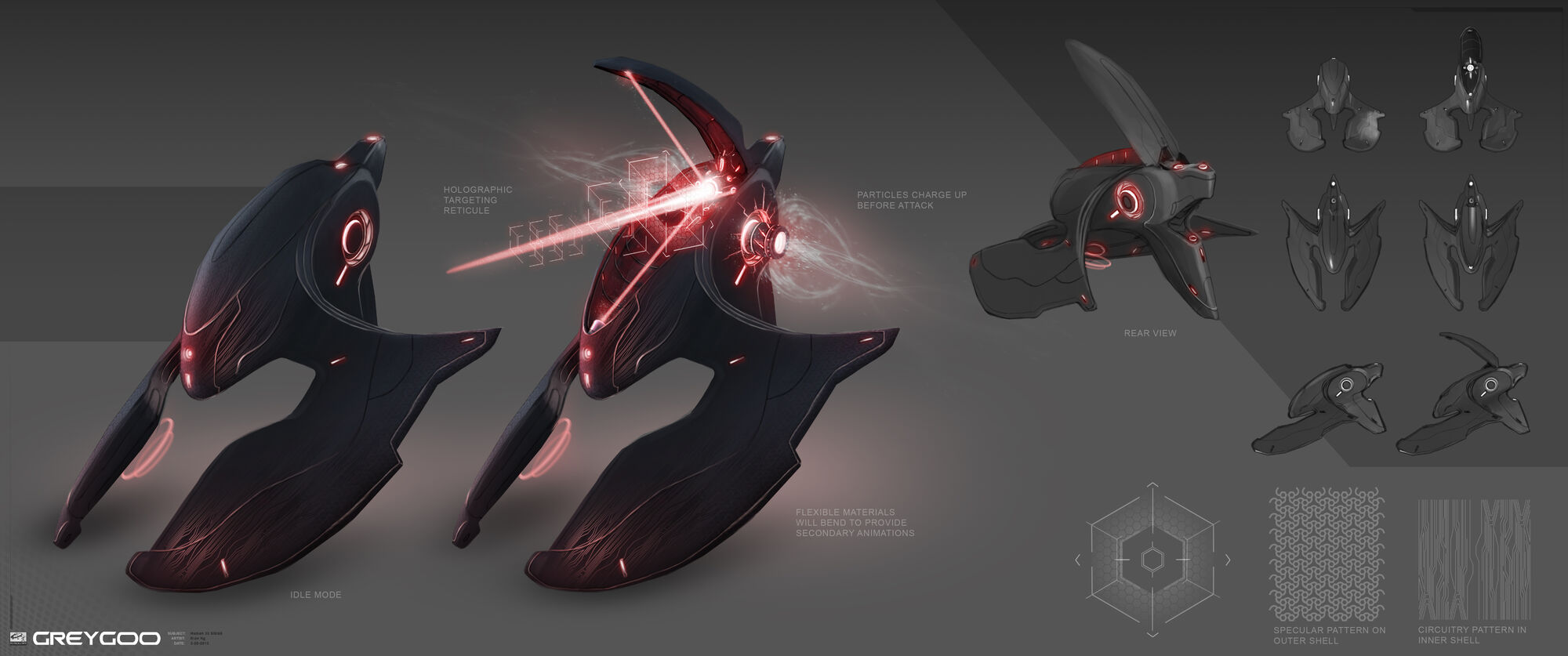
While Grey Goo is arguably not nearly as good a game as StarCraft 2, I personally feel that the strategic and tactical choice around this upgrade is far more interesting than almost any upgrade in Blizzard’s far more popular game.
Not every upgrade in Grey Goo has the same level of interest: another upgrade choice for the Humans turns harvester units invisible, while there’s one that allows certain classes of turret to remain powered even when they’re supposed to be offline. But, to me, this one example is perfect to describe what I’m looking for. This is a meaningful choice that has a dramatic impact on the game.
The Dawn of War games have similar choices: The Necron Lord, for instance, has to choose a limited number of Wargear items to research at any given time, and many squads have mutually exclusive upgrades that change how they handle combat. Individual Chaos Space Marines squads, for example, can choose to outfit themselves with either the Mark of Khorne, which makes them melee specialists, or the Mark of Tzeentch, which specializes them against heavy foes.
These upgrades provide players with dramatic choices that have dramatic results. They provide clear benefits and downsides that are intelligible and understandable, and have readable impacts for both the player and their opponent. To me, this is much preferred over invisible stat bonuses with entirely mechanical considerations and little impact on how the game is played but instead only provide impact on the outcomes of that play.
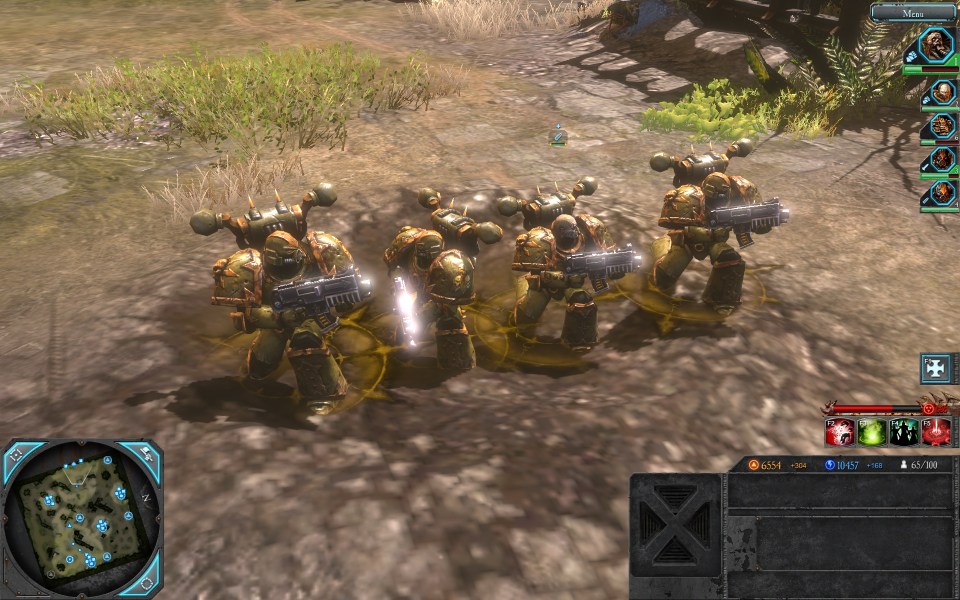
Similarly, I wish I could track down a quality image or other recording of how upgrades work in Universe at War: Earth Assault. In UAW (as it’s often abbreviated), each faction has 3 separate tech paths, each with 4 upgrades. Each upgrade takes time and increasing amounts of money to unlock. More interestingly, the player can only choose a total of 6 out of the 12 upgrades, and each upgrade unlocks the next one in its sequence. This often force the player to choose all 4 unlocks from one tech path and 2 from another, or 4 – 1 – 1, or 3 – 3, or some other combination depending on their strategy.
The upgrades in UAW unlocked new abilities to units, added Node types for one faction’s giant walker robots, and generally were central to defining how a faction approached the game. Whether the player wanted to focus on debuffs, or fast mobile attackers, or heavy hitting, there were multiple upgrade paths that allowed them to focus more in one direction or another. And with both UAW and Grey Goo, players had the flexibility to remove and repurchase their selected upgrades, to change their approach with a bit of lead time.
In Conclusion
I feel like I’ve rambled a bit in this article. I’ve tried to make the point that upgrades are an ephemeral but important part of RTS games, and to discuss their place between the more tangible assets of units and structures.
I’ve tried to approach my position on the topic openly and honestly: talking about my preferences and my reasoning for them instead of a hypothetical best thing for the genre.
I am a favor of clarity and readability in games. To allow the results of choices to be dramatic and understandable: a different weapon, a change in function, a change that is noticeable and digestible by all affected parties. I feel like upgrades should provide options for players to help refine their strategy, instead of minor, mostly hidden mechanical modifiers that act as simple force multipliers.
Thanks for reading.




I’ve had a draft in my head about upgrades for a long time that I could never get organized well and it was something I think would have been fun to discuss in a round table rather than an article but this is nicely done. I personally put upgrades into three categories:
1. Straight stat upgrades (think the normal upgrades from SC2
2. Unit altering upgrades (so upgrades that change the function of a unit by increasing versatility or improving their current role)
3. No upgrades (recent Petroglyph games for example)
I think all three can work and that you will see #1 and #2 combined regularly but even #3 is fine in the right game. I enjoy the simplicity of the 8-Bit games and they lack upgrades entirely and it fits because the game has fewer phases. I do think Petroglyph erred when they excluded upgrades from the more complex Forged Battalion but at the same time that game has so much customization that I’m not sure how anything other that straight stat upgrades would work. I personally prefer a combination of #1 and #2 because #1 creates phases of power in the game which I think are exciting and I think #2 is nice because it gives units new roles as the game goes on and potentially gives units longer shelf life so they aren’t regulated to a very niche timing.
Also side note, can I say upgrades (and stats in general) should always be specific, whether it is stat upgrades being percentage based or raw numbers, or giving units new abilities or functions, the designer needs to be specific because otherwise it is so frustrating for the user to not know how much more powerful/durable their units are post-upgrade or having no idea how practical the new ability will be.
Thanks for the article!
LikeLiked by 2 people
Another good article.
You are often referencing lots of RTS games as examples to point to when explaining an idea. I enjoy this, but I keep hoping you will fill in a blind spot that is missing from your reference tool-box.
PLEASE play Zero-K and consume it’s systems so that it can inform the rest of your strategy examination. This is both a selfish desire and because I genuinely believe it is uniquely suited for your style of analysis.
It’s the gold standard of so many systems that I end up instinctively reaching for it as an example whenever I read one of your essays. So, for that reason, I’d really like for you to play Zero-K and talk about it. Thanks.
LikeLiked by 1 person
CHALLENGE
ACCEPTED
LikeLiked by 1 person
I think it’s important to differentiate between Quantitative Upgrades, things that make number-go-up, such as Starcraft armory upgrades or units getting exp, and Qualitative Changes, things that alter how a unit functions, such as the Siege Mode research in the original Starcraft.
While quantitative upgrades can create interesting situations, the player often feels divorced from them, and has trouble seeing exactly what effect they have on the game. The zergling vs zealot matchup you mentioned, for example, is something that I bet very few players know as it’s not well communicated in-game.
Qualitative upgrades/sidegrades are often far more interesting to players, as they can immediately feel how they alter the game. In addition, they are often visually communicated far better, as either alterations to the unit model (such as squad equipment in Dawn of War) or by seeing the ability in use.
Another interesting point is the granularity of quantitative upgrades – while the upgrades in Starcraft can feel fairly unimpressive, something like Advanced Metalurgy in Dark Crusade feels more like a qualitative change, simply because the effect it has on unit health is so massive.
LikeLiked by 1 person
Broodwar has a lot of mandatory research upgrades though, you need vulture speed for them to perform their intended role, same with siege mode and the siege tank. There’s never any doubt you’ll get these upgrades, so they don’t create many interesting choices outside of what order you get them in.
LikeLiked by 1 person
Do you mean the unit is completely useless unless you get the upgrade, or is this only true with high level players? I’d definitely say the siege tank and siege mode are a case of not getting one without the other, but I haven’t heard of vulture speed being absolutely necessary. That and I feel a major problem with making rts games is how possessive the competitive players are, arguing that if a game doesn’t cater to them then it is worthless and the focus on e sports often to the detriment of casual or mediocre players. It feels like all too often when people talk about what’s good for rts games they are referring to the top 5% of players and ignoring the rest.
LikeLike
Well seige mode is the best example, but I’d argue vulture speed is vital for the vulture to properly perform it’s role as a fast commerce raider which is a role useful to players of all abilities.
I think that’s getting lost in the weeds a bit, my point was that having a research which is mandatory is not creating any fun decisions, it just is another gate/ apm test before you can use your unit. The cleric from Warcraft 1 is another good example, where you have to research heal seperately!
LikeLiked by 1 person
I think Universe at War’s faction design and tech trees are genius, so I definitely agree with that.
I think a major part of that was not just how mechanically different and weird the upgrades were, but how they fit so well with the factions’ themes from an intuitive sense. The Masari are based on ancient astronauts and so have two modes, like the two sides of Abrahamic cosmology. The “angelic” side is surrounded by blazing flames and can fly, while the “demonic” side has these dark shields and no air units. Their tech tree further improves upon these, with the light branch giving more damage abilities, while the dark tree upgrades repelling abilities and the aforementioned shield. UaW has tech trees that are interesting from a gameplay perspective and in how they support the lore of their faction.
I wonder what you think about highly themed rts games, such as UaW, vs. less highly themed ones; ones where the factions’ gameplay really embodies their lore, vs. when they seem like a palette swap with a few stat tweaks.. I think the former is much better because it can keep player interest. Yes, UaW’s factions are stereotypes, but they work with their gameplay incredibly well. As opposed to something like AoE2 where the Mongols have the same infantry as the Britons and the Aztec. While not every game can have as asymmetrical factions as UaW, I feel that developers should er on having a few highly unique factions over many similar ones. Maybe more like the first Dawn of War, but if each faction can be summed up as a half dozen bonuses and one unique unit out of dozens, then it really feels like a waste. Sure you can put on the back of the box “More than a dozen different factions!” but the actual tools the factions have access to are mostly the same as every other faction.
I definitely agree that qualitative upgrades or even sidegrades are better than +1 to peasant attack. I know my most played game on Steam, Sins of a Solar Empire, has several techs that are “+5% to damage type.” and “+ 12% to health and 10% to health regen.” but it also has some wonderfully flavorful upgrades, especially in the Rebellion expansion. For example, the TEC rebels are a bunch of former merchants forced to fight a hive mind cult their ancestors exiled and nomadic planet looter aliens. Well, they can make the third party militia that guard worlds neutral, allowing them to expand like crazy, or gain credits when their ships bomb enemy worlds. Oh, and the loyalist nomadic planet looters? They get the ability to destroy entire planets increasing their stores and leaving nothing behind but an asteroid.
Speaking of SoaSE I wonder if you think “meta” tech trees are better or worse in some situations. On one hand I like it when you can’t just plop one building down in the middle of your base and have to think about where to put it, which seems quite common with meta tech trees. On the other Supreme Commander 2 (which has a meta tree) also had a very interesting twist on tech. In Sup Com 2, all tech costed only research points which the player gathered from research stations and combat. It effectively allowed the player to advance simultaneously through the tech tree and build a large army, since the resource bottleneck was one step removed. You could build several research centers early on and use them to get the tech you liked, while spending your mass and energy on units and buildings. It makes me wonder how what resources are used to buy could change games.
LikeLiked by 1 person